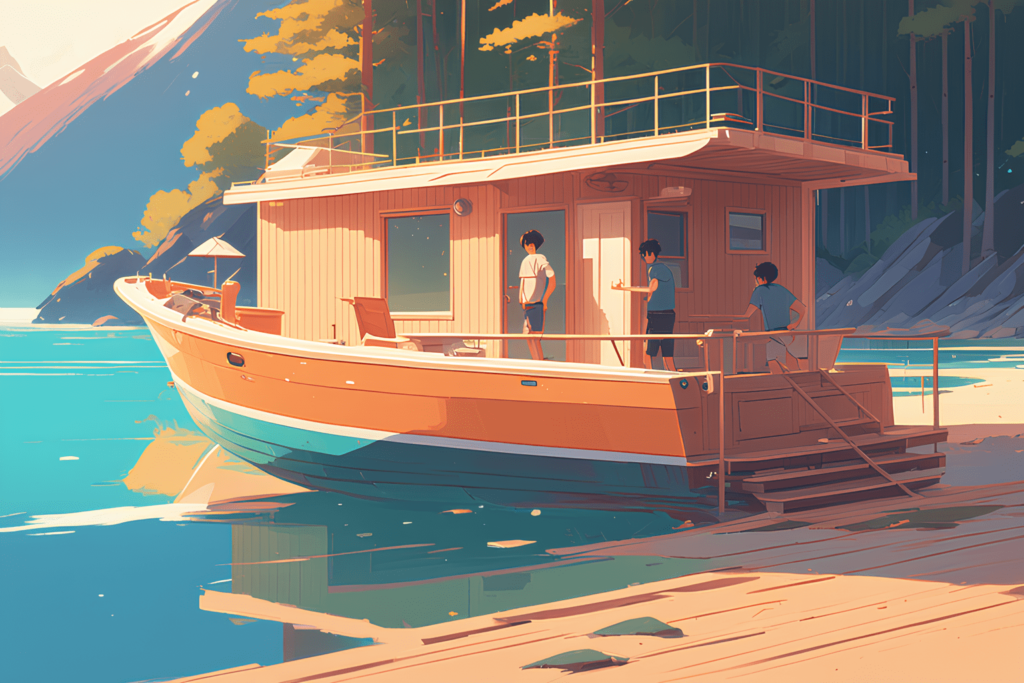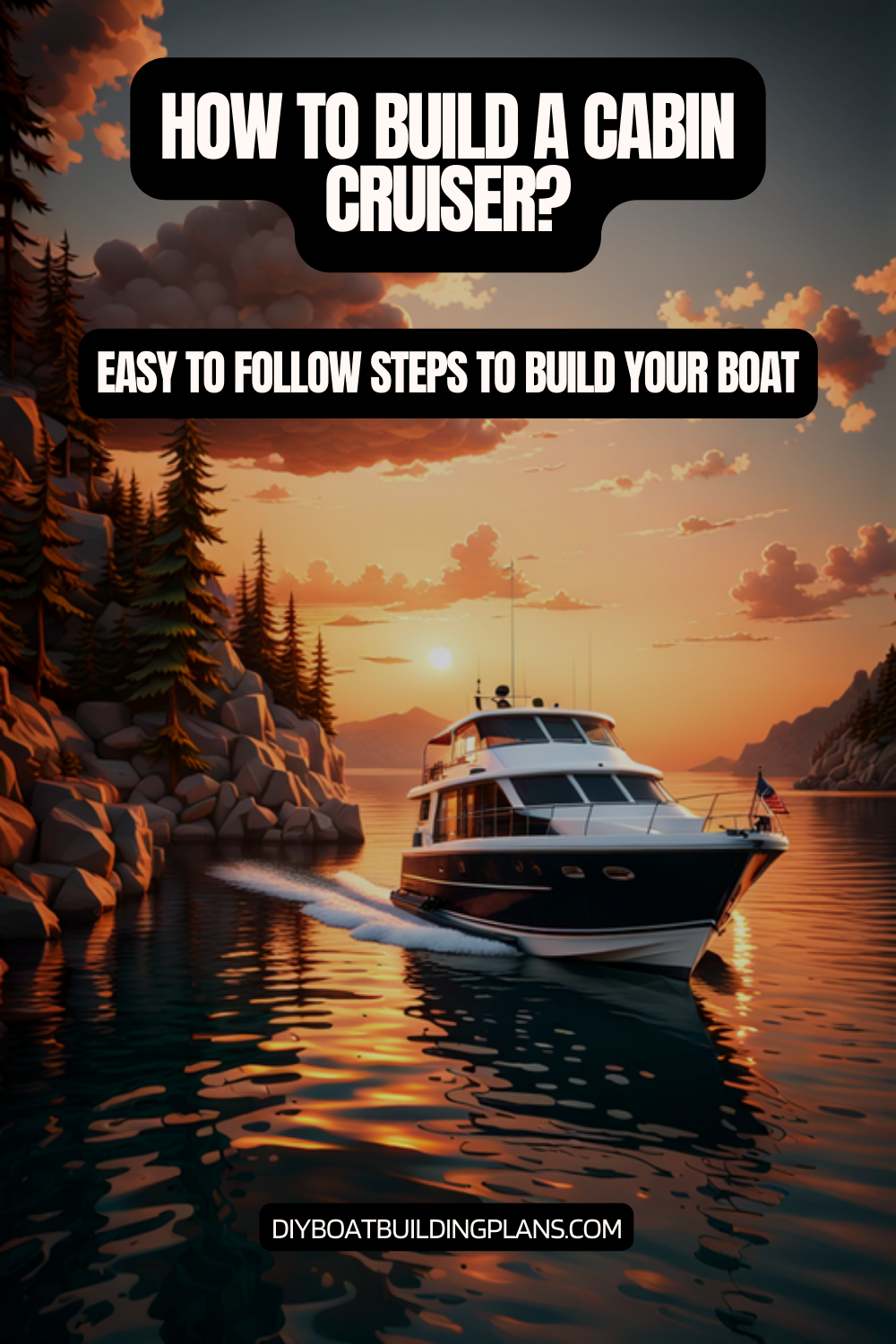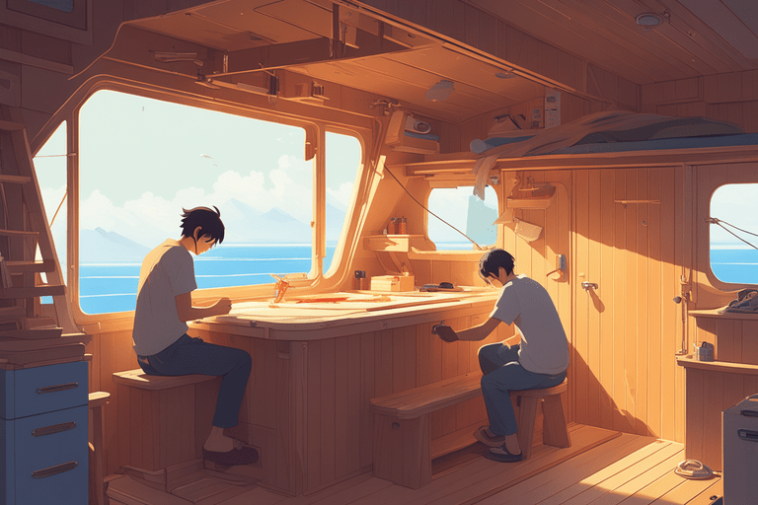Key Takeaways – How To Build a Cabin Cruiser
⚓ Cabin cruisers offer a blend of comfort and performance, designed for passengers, high-speed cruising, and various water conditions, suitable for recreation, fishing, or even living aboard.
🚤 Various types of cabin cruisers are available, including express cruisers, flybridge cruisers, aft cabin cruisers, and trawler cruisers, each with unique characteristics and features.
🛠️ Building your own cabin cruiser allows customization, cost savings, skill development, and an enjoyable DIY experience. You can choose materials, tools, and designs that suit your preferences.
🧰 Tools and materials needed for cabin cruiser construction include measuring tape, saw, drill, epoxy, fiberglass, paint, and various hardware components. The exact requirements depend on your boat’s design.
🕐 The time it takes to build a cabin cruiser varies based on factors like boat size, complexity, builder’s experience, and working conditions. Typically, it can take from 6 months to 2 years.
🤔 While building a cabin cruiser can present challenges, like design selection, material sourcing, and precision in construction, these issues can be addressed with patience, research, and assistance from experts or friends.
🚧 Common mistakes to avoid include selecting an inappropriate design, using poor-quality materials, rushing through steps, neglecting safety rules, and postponing maintenance or repairs.
🏗️ The cabin cruiser construction process involves cutting panels, stitching them together using the stitch-and-glue method, adding bulkheads for structural integrity, and fairing the hull for a smooth surface.
🌊 Applying fiberglass, painting the cruiser, installing hardware components, and adding personal touches complete the boat-building project.
What is a Cabin Cruiser?
Cabin cruisers are a type of boat that offer both comfort and performance. They are designed to accommodate passengers and crew in a spacious cabin, while also being able to cruise at high speeds and navigate various water conditions. Cabin cruisers are ideal for recreational boating, fishing, or living aboard.
Different Types of Cabin Cruisers
There are many different types of cabin cruisers available, depending on the size, shape, style, and features of the boat. Some of the most common types are:
- Express cruisers: These are fast and sleek boats that have a single-level deck and a large cockpit. They usually have a small cabin with a V-berth and a head. They are suitable for day trips or overnight stays.
- Flybridge cruisers: These are similar to express cruisers, but they have an additional deck above the main deck, called the flybridge. This provides more space for seating, steering, and navigation. They usually have a larger cabin with more amenities, such as a galley and a dinette. They are suitable for longer trips or extended stays.
- Aft cabin cruisers: These are boats that have a cabin at the rear of the boat, called the aft cabin. This provides more privacy and comfort for the passengers and crew. They usually have a spacious salon, a galley, and a head on the main deck, and a master stateroom and a guest stateroom on the lower deck. They are suitable for luxury cruising or living aboard.
- Trawler cruisers: These are boats that have a displacement hull, which means they move through the water rather than on top of it. This makes them more stable and fuel-efficient, but also slower than other types of cabin cruisers. They usually have a large cabin with a pilothouse, a salon, a galley, and a head on the main deck, and one or more staterooms on the lower deck. They are suitable for long-distance cruising or exploring.
The following table summarizes some of the main differences between these types of cabin cruisers:
| Type | Speed | Fuel Efficiency | Cabin Size | Deck Layout |
|---|---|---|---|---|
| Express cruiser | High | Low | Small | Single-level |
| Flybridge cruiser | High | Low | Medium | Two-level |
| Aft cabin cruiser | Medium | Medium | Large | Single-level |
| Trawler cruiser | Low | High | Large | Two-level |
Benefits of Building Your Own Cabin Cruiser
Building your own cabin cruiser can be a rewarding and satisfying experience. Some of the benefits of building your own cabin cruiser are:
- You can customize it to your preferences: You can choose the design, size, shape, style, and features of your boat according to your needs and tastes. You can also add or modify any details or components as you wish.
- You can save money: You can avoid paying for labor costs, dealer fees, taxes, or other expenses that come with buying a ready-made boat. You can also source your own materials and tools at lower prices than buying them from a boat builder or supplier.
- You can learn new skills: You can develop your carpentry, engineering, electrical, plumbing, and navigation skills as you build your boat. You can also gain more knowledge about boat design, construction, maintenance, and repair.
- You can have fun: You can enjoy the process of creating something with your own hands and seeing it come to life. You can also share your passion and enthusiasm with your family and friends who can help you or join you in your boating adventures.
Tools and Materials Needed
To build your own cabin cruiser, you will need some basic tools and materials that are essential for boat building. Some of the tools and materials needed are:
- Tools:
- Measuring tape
- Pencil
- Saw
- Drill
- Zip ties
- Epoxy
- Fiberglass
- Paint
- Brushes
- Rollers
- Sander
- Screwdriver
- Wrench
- Hammer
- Nails
- Screws
- Bolts
- Nuts
- Washers
- Materials:
- Plywood
- Lumber
- Marine hardware
- Seats
- Windows
- Doors
- Galley
- Cushions
- Curtains
- Dishes
- Engine
- Transmission
- Propeller
- Rudder
- Anchor
- Winch
- Electrical system
- Plumbing system
- Navigation system
- Safety equipment
The exact tools and materials needed may vary depending on the type and design of your cabin cruiser. You can find more information and guidance on the plans or kits that you choose to follow.
Safety Tips
Building your own cabin cruiser can be a fun and rewarding experience, but it also involves some risks and hazards. Therefore, it is important to follow some safety tips to ensure your well-being and the quality of your boat. Some of the safety tips are:
- Wear protective gear: You should wear gloves, goggles, masks, ear plugs, and other protective gear when working with tools and materials that can cause injuries or health issues. You should also wear appropriate clothing and footwear that can protect you from cuts, burns, or slips.
- Work in a well-ventilated area: You should work in an area that has enough air circulation and ventilation to prevent the accumulation of dust, fumes, or vapors that can affect your breathing or vision. You should also avoid working near open flames or sparks that can ignite flammable materials or substances.
- Follow the instructions: You should follow the instructions and guidelines provided by the plans or kits that you choose to follow. You should also check the specifications and compatibility of the tools and materials that you use. You should also test and inspect your boat before launching it to ensure its safety and performance.
- Seek help when needed: You should seek help from experts or professionals when you encounter any difficulties or challenges that are beyond your skill level or knowledge. You should also ask for assistance from your family or friends when you need to lift, move, or install heavy or bulky items.

Building the Hull
The hull is the main body of the boat that provides buoyancy, stability, and shape. It is also the most challenging and time-consuming part of building a cabin cruiser. To build the hull, you will need to choose a design, cut the panels, stitch them together, add the bulkheads, and fair the hull.
Choosing a Design
There are many different cabin cruiser designs available, both online and in books. You can choose a design that is appropriate for your skill level and the type of boating you plan to do. Some of the factors to consider when choosing a design are:
- Size: The size of your cabin cruiser will affect its performance, comfort, and cost. You should choose a size that fits your budget, space, and transportation needs. You should also consider the number of passengers and crew that you intend to accommodate on your boat.
- Shape: The shape of your cabin cruiser will affect its hydrodynamics, aesthetics, and interior layout. You should choose a shape that suits your style and preferences. You should also consider the water conditions that you expect to encounter on your boating trips.
- Style: The style of your cabin cruiser will affect its appearance and features. You should choose a style that reflects your personality and taste. You should also consider the level of comfort and convenience that you desire on your boat.
Some of the popular cabin cruiser styles are:
- Classic: These are cabin cruisers that have a traditional or vintage look. They usually have a round or v-shaped hull, a wooden or fiberglass exterior, and a cozy or elegant interior. They are suitable for boaters who appreciate history and nostalgia.
- Modern: These are cabin cruisers that have a contemporary or futuristic look. They usually have a flat or curved hull, a metal or composite exterior, and a sleek or minimalist interior. They are suitable for boaters who value innovation and technology.
- Sporty: These are cabin cruisers that have a dynamic or adventurous look. They usually have a sharp or angular hull, a colorful or flashy exterior, and a functional or versatile interior. They are suitable for boaters who enjoy speed and excitement.
The following chart shows some examples of cabin cruiser designs based on their size, shape, and style:
| Size | Shape | Style | Example |
|---|---|---|---|
| Small | Round | Classic | Glen-L 15 |
| Small | Flat | Modern | Seaclipper 16 |
| Small | Sharp | Sporty | MiniMax |
| Medium | V-shaped | Classic | Cabin Skiff |
| Medium | Curved | Modern | Eco 55 |
| Medium | Angular | Sporty | Sea Strike 18 |
| Large | Round | Classic | Grand Banks 42 |
| Large | Flat | Modern | Solarwave 64 |
| Large | Sharp | Sporty | Sunseeker Predator 74 |
Cutting the Panels
Once you have chosen a design, you will need to cut the plywood panels to size. Plywood is a common material for building cabin cruisers because it is strong, lightweight, and easy to work with. You will need to use marine-grade plywood that is resistant to water and rot.
To cut the panels, you will need to use a saw, a measuring tape, a pencil, and a pair of scissors. You will also need to follow the plans carefully and mark the dimensions and shapes of the panels on the plywood sheets. You should cut the panels slightly larger than the marked dimensions to allow for trimming and fitting later.
The following steps describe how to cut the panels:
- Lay the plywood sheet on a flat surface and secure it with clamps or weights.
- Measure and mark the dimensions and shapes of the panels on the plywood sheet using a measuring tape and a pencil.
- Cut along the marked lines using a saw. Be sure to use sharp blades and to cut slowly and steadily.
- Trim any excess material using scissors or sandpaper.
- Repeat steps 1 to 4 for each panel.
Stitching the Panels Together
The stitch-and-glue method is a popular way to build cabin cruisers. It involves stitching the panels together using zip ties and then applying epoxy to the seams to seal them. This method is simple, fast, and effective, and does not require any frames or molds.
To stitch the panels together, you will need to use a drill, zip ties, epoxy, and fiberglass tape. You will also need to follow the plans carefully and align the edges of the panels correctly. You should stitch the panels loosely at first and then tighten them gradually as you apply the epoxy.
The following steps describe how to stitch the panels together:
- Drill holes along the edges of the panels using a drill. The holes should be about 1 inch apart and about 1/4 inch from the edge.
- Insert zip ties through the holes and pull them tight to join the panels together. You should start from one end and work your way to the other end, making sure that the panels are aligned and flush.
- Mix epoxy according to the instructions on the product label.
- Apply epoxy to the seams using a brush or a roller. You should cover both sides of the seam and overlap the edges of the panels by about 1/2 inch.
- Apply fiberglass tape over the epoxy and press it firmly into place. The fiberglass tape will reinforce the seam and prevent cracking or leaking.
- Cut off any excess zip ties using scissors or pliers.
- Repeat steps 1 to 6 for each seam.
Adding the Bulkheads
Bulkheads are structural members that provide strength and rigidity to the hull. They are usually made of plywood or lumber and are installed perpendicular to the hull at regular intervals. They also divide the hull into different compartments, such as the cabin, the cockpit, and the engine room.
To add the bulkheads, you will need to use a saw, a drill, screws, epoxy, and fiberglass tape. You will also need to follow the plans carefully and position the bulkheads correctly. You should attach the bulkheads to the hull using screws and then seal them using epoxy and fiberglass tape.
The following steps describe how to add the bulkheads:
- Cut the bulkheads to size using a saw. You should follow the dimensions and shapes given by the plans.
- Drill holes on the edges of the bulkheads using a drill. The holes should be about 2 inches apart and about 1/2 inch from the edge.
- Position the bulkheads inside the hull according to the plans. You should make sure that they are perpendicular to the hull and aligned with the seams.
- Attach the bulkheads to the hull using screws. You should insert screws through the holes on the bulkheads and into the hull panels.
- Mix epoxy according to the instructions on the product label.
- Apply epoxy to the joints between the bulkheads and the hull using a brush or a roller. You should cover both sides of the joint and overlap the edges of the bulkheads and hull by about 1/2 inch.
- Apply fiberglass tape over the epoxy and press it firmly into place. The fiberglass tape will reinforce the joint and prevent cracking or leaking.
- Repeat steps 1 to 7 for each bulkhead.
Fairing
Fairing is a process of sanding or filling in any gaps or irregularities on the surface of your boat until it is smooth and even.
Fairing is important for both aesthetic and functional reasons.
A smooth surface will improve your boat’s appearance, performance, and durability.
Download over 500 Boat Plans. Click on the link below.
-->Click Here<--
To fair your boat, you will need to use sandpaper, filler, epoxy, a sander, a scraper, a brush, a roller, and a cloth.
You will also need to follow these steps:
- Inspect your boat for any gaps, holes, dents, or bumps on its surface.
- Fill in any gaps or holes with filler or epoxy.
- Sand down any dents or bumps with sandpaper or a sander.
- Apply a thin layer of epoxy over your boat’s surface with a brush or a roller.
- Smooth out any excess epoxy with a scraper or a cloth.
- Let your boat dry completely before painting it.
Sure, I can write the next part of the article for you. Here is what I have generated based on your outline and keywords:
Finishing the Cabin Cruiser
Once you have built the hull, you are ready to finish your cabin cruiser by applying fiberglass, painting it, installing the hardware, and adding the finishing touches. These steps will make your boat more durable, attractive, and comfortable.
Applying Fiberglass
Fiberglass is a material that consists of thin fibers of glass that are woven together and coated with resin. Fiberglass adds strength and durability to your boat’s hull, as well as protection from water, weather, and UV rays.
To apply fiberglass to your boat, you will need to use fiberglass cloth, epoxy resin, hardener, brushes, rollers, scissors, and gloves. You will also need to follow these steps:
- Cut the fiberglass cloth to size using scissors. You should cover the entire surface of your boat’s hull with overlapping pieces of fiberglass cloth.
- Mix the epoxy resin and hardener according to the instructions on the product label. You should use a disposable container and a wooden stick to mix them well.
- Apply the epoxy mixture to the hull using a brush or a roller. You should work in small sections and spread the epoxy evenly and thinly over the hull.
- Lay the fiberglass cloth over the epoxy and press it firmly into place. You should smooth out any wrinkles or bubbles with your hands or a roller.
- Apply another layer of epoxy over the fiberglass cloth and repeat steps 3 and 4 until you have covered the entire hull with fiberglass.
- Let the fiberglass cure completely before moving on to the next step.
Painting the Cabin Cruiser
Once the fiberglass has cured, you can paint your cabin cruiser. Painting your boat will improve its appearance and prevent fading or discoloration. You can choose any color or design that you like for your boat.
To paint your boat, you will need to use marine paint, primer, thinner, brushes, rollers, masking tape, and newspaper. You will also need to follow these steps:
- Sand the fiberglass surface lightly with sandpaper to remove any rough or uneven spots.
- Clean the hull with water and soap to remove any dust or dirt.
- Mask off any areas that you do not want to paint with masking tape and newspaper.
- Apply a coat of primer to the hull using a brush or a roller. The primer will help the paint adhere better and last longer.
- Let the primer dry completely before applying the paint.
- Apply a coat of paint to the hull using a brush or a roller. You should use a marine paint that is designed to withstand the elements and resist peeling or cracking.
- Let the paint dry completely before applying another coat if needed.
- Remove the masking tape and newspaper carefully after the paint has dried.
Installing the Hardware
Once the paint has dried, you can install the hardware on your boat. Hardware refers to any metal or plastic parts that are attached to your boat, such as seats, windows, doors, galley, engine, transmission, propeller, rudder, anchor, winch, electrical system, plumbing system, navigation system, and safety equipment.
To install the hardware on your boat, you will need to use screws, bolts, nuts, washers, wrenches, screwdrivers, hammers, drills, epoxy, and silicone sealant.
You will also need to follow these steps:
- Position the hardware on your boat according to the plans or instructions that come with them.
- Drill holes on your boat’s hull or deck where you want to attach the hardware using a drill.
- Insert screws or bolts through the holes and secure them with nuts and washers using wrenches or screwdrivers.
- Apply epoxy or silicone sealant around the screws or bolts to seal them and prevent water leakage.
- Repeat steps 1 to 4 for each piece of hardware that you want to install on your boat.
Adding the Finishing Touches
Once you have installed all the hardware on your boat, you can add the finishing touches to make it more cozy and personal.
The finishing touches include any items that enhance the comfort and appearance of your boat, such as cushions, curtains, dishes, pictures, or decorations.
To add the finishing touches to your boat, you will need to use glue, tape, nails, or hooks.
You will also need to follow these steps:
- Arrange the cushions on your seats and beds to make them more comfortable and colorful.
- Hang the curtains on your windows and doors to provide privacy and shade.
- Place the dishes in your galley and cabinets to prepare for meals and snacks.
- Display the pictures or decorations on your walls or shelves to show off your personality and style.
- Enjoy your cabin cruiser and have fun on your boating adventures.

FAQs – How To Build a Cabin Cruiser
Building your own cabin cruiser can be a rewarding and satisfying experience, but it can also raise some questions and doubts. In this section, we will answer some of the most frequently asked questions about building cabin cruisers. If you have any other questions, feel free to contact us or consult a professional boat builder.
What kind of wood should I use to build a cabin cruiser?
The most common and recommended wood for building cabin cruisers is marine-grade plywood. Marine-grade plywood is specially treated to resist water and rot, and it is strong, lightweight, and easy to work with. You can find marine-grade plywood at most boat supply stores or online.
Other types of wood that you can use to build cabin cruisers are cedar, fir, mahogany, oak, or teak. These woods are also durable and resistant to water and rot, but they are more expensive and harder to find than plywood. You can use these woods to add some accents or details to your boat, such as trim, rails, or furniture.
You should avoid using regular or untreated plywood, as it will warp, crack, or decay when exposed to water or moisture. You should also avoid using soft or porous woods, such as pine, spruce, or balsa, as they will absorb water and become weak or brittle.
What tools do I need to build a cabin cruiser?
The tools that you need to build a cabin cruiser depend on the type and design of your boat, but some of the basic tools that you will need are:
- Measuring tape
- Pencil
- Saw
- Drill
- Zip ties
- Epoxy
- Fiberglass
- Paint
- Brushes
- Rollers
- Sander
- Screwdriver
- Wrench
- Hammer
- Nails
- Screws
- Bolts
- Nuts
- Washers
You can find most of these tools at your local hardware store or online. You should also make sure that your tools are sharp, clean, and in good condition before using them.
How long does it take to build a cabin cruiser?
The time that it takes to build a cabin cruiser depends on several factors, such as the size, shape, style, and complexity of your boat, the skill level and experience of the builder, the availability and quality of the materials and tools, and the weather and working conditions.
However, as a general estimate, you can expect to spend anywhere from 6 months to 2 years to build a cabin cruiser. This includes the time for planning, designing, sourcing, cutting, stitching, gluing, fairing, painting, installing, and finishing your boat.
Of course, you can speed up or slow down the process depending on your preferences and circumstances. You can also work on your boat part-time or full-time depending on your schedule and availability.
How difficult is it to build a cabin cruiser?
The difficulty of building a cabin cruiser depends on several factors, such as the type and design of your boat, the skill level and experience of the builder, the availability and quality of the materials and tools, and the guidance and support that you receive.
However, as a general estimate, you can expect to face some challenges and difficulties when building a cabin cruiser. Some of the common challenges and difficulties are:
- Finding a suitable design that meets your needs and tastes.
- Finding a suitable place to work on your boat that has enough space, light, ventilation, and security.
- Finding suitable materials and tools that are affordable, available, and compatible with your boat.
- Following the instructions and guidelines provided by the plans or kits that you choose to follow.
- Measuring, cutting, stitching, gluing, fairing, painting, installing, and finishing your boat with accuracy, precision, and quality.
- Dealing with any errors, mistakes, or accidents that may occur during the process.
- Testing and inspecting your boat before launching it to ensure its safety and performance.
Of course, you can overcome these challenges and difficulties with some patience, perseverance, and creativity. You can also seek help from experts or professionals when you encounter any problems or issues that are beyond your skill level or knowledge. You can also ask for assistance from your family or friends who can help you or join you in your boating adventures.
What are some common mistakes to avoid when building a cabin cruiser?
Building a cabin cruiser can be a fun and rewarding experience, but it can also involve some mistakes that can affect the quality or safety of your boat. Some of the common mistakes to avoid when building a cabin cruiser are:
- Choosing a design that is too complex or too simple for your skill level or boating needs.
- Using poor quality or incompatible materials or tools that can compromise the strength or durability of your boat.
- Skipping or rushing any steps or stages of the process that can result in errors or defects on your boat.
- Ignoring or violating any safety rules or regulations that can endanger your health or well-being or that of others.
- Neglecting or postponing any maintenance or repair tasks that can damage or deteriorate your boat.
To avoid these mistakes, you should do some research and planning before starting your project. You should also follow the instructions and guidelines provided by the plans or kits that you choose to follow. You should also check and double-check your work before moving on to the next step. You should also wear protective gear and work in a well-ventilated area when working with tools and materials that can cause injuries or health issues. You should also test and inspect your boat before launching it to ensure its safety and performance.
Conclusion – How To Build a Cabin Cruiser
Building your own cabin cruiser can be a rewarding and satisfying experience that allows you to customize your boat to your preferences, save money, learn new skills, and have fun. However, it also requires some planning, preparation, and patience, as well as some tools, materials, and guidance.
In this article, we have covered the main steps and aspects of building a cabin cruiser, such as choosing a design, cutting the panels, stitching them together, adding the bulkheads, fairing the hull, applying fiberglass, painting the boat, installing the hardware, and adding the finishing touches. We have also answered some of the most frequently asked questions about building cabin cruisers.
We hope that this article has inspired you to start your own boat building project and that you will enjoy your cabin cruiser for many years to come. 😊



